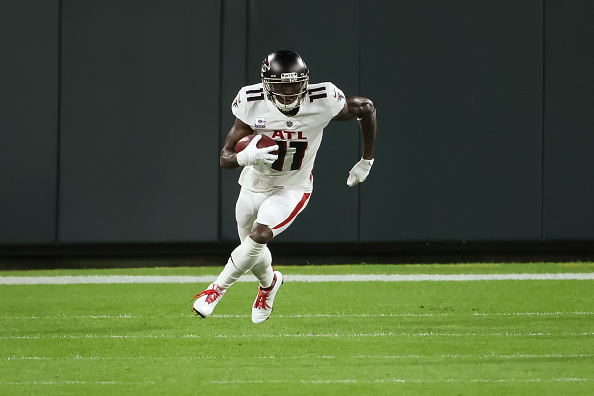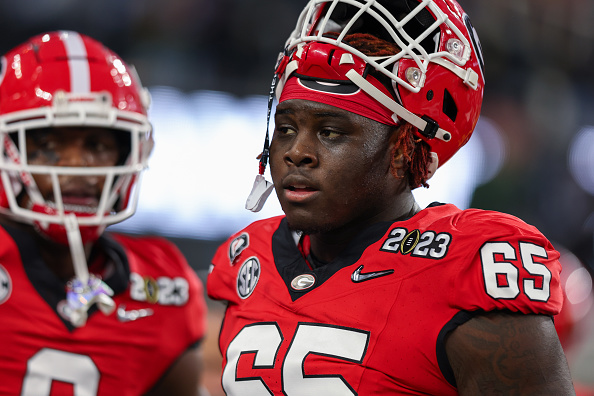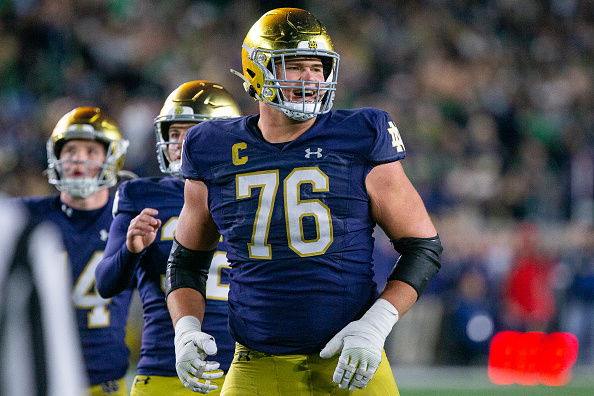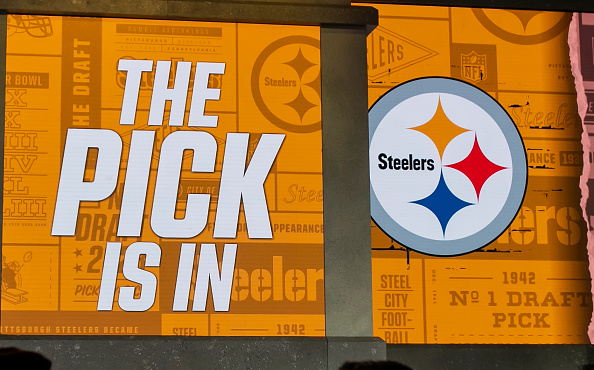It’s finally happening! After months of speculation, rumor, and reports, the Atlanta Falcons have traded away arguably the best player in franchise history. Between salary cap issues and a losing culture over the last several years, the Falcons have traded Julio Jones to the Tennessee Titans. The Falcons will receive a 2022 second-round pick and a 2023 fourth-round pick in exchange for Jones and a 2023 sixth-round pick. The trade has a massive impact on both teams as the Falcons could be heading towards a complete rebuilding phase soon. Meanwhile, the Titans are pushing all their chips in at a Super Bowl run this season.
The #Titans deal for Julio Jones:
— The #Falcons get a 2022 2nd rounder and a 2023 4th rounder.
— The #Titans get Julio Jones & a 6th rounder in 2023.
— The #Titans take on Jones’ salary of $15.3M in 2021 and the rest of the deal.
— #Falcons have $7.75M in dead money this year.— Ian Rapoport (@RapSheet) June 6, 2021
On the field, the Falcons have the pieces needed to be competitive this season but likely won’t make the playoffs. For the Titans, this move gives their season a Super Bowl or bust expectation. However, fantasy football players don’t care whether the Falcons go 0-17 or the Titans go 20-0 and win the Super Bowl. All that matters to them is how the Jones trade impacts the fantasy world, and more importantly, their fantasy teams. So, let’s dive into some winners and losers from the Julio trade.
All stats and projections are base on six points per passing touchdown and PPR scoring.
Massive Winners
Ryan Tannehill, QB, Tennessee Titans
When the Titans let Corey Davis walk in free agency, many expected the Titans to lean on the running game even more this season. This wasn’t good news for Tannehill, as he was coming off a career-high 33 passing touchdowns and 409.4 fantasy points last year. However, as great as Davis played last year, the Titans have clearly upgraded with the addition of Jones. Pairing Jones with A.J. Brown gives Tannehill arguably the best wide receiver duo in the league. Despite throwing only 481 times last season, Tannehill’s 6.9 percent touchdown rate can repeat this season. Unless Julio or Brown misses substantial time this season, Tannehill went from a streaming option to a borderline weekly starter.
Calvin Ridley, WR, Atlanta Falcons
Last season, Ridley finished the year as the WR5, averaging 18.8 fantasy points per game. With Julio missing seven games, Ridley stepped up his play in those contests, averaging 11.3 targets and 20.3 fantasy points per game. Meanwhile, over the last two seasons, Julio has averaged 9.4 targets per game for the Falcons. While the rookie, Kyle Pitts, will see a chunk of Julio’s targets, expect Ridley to lead the league in targets this season. If Julio had stayed in Atlanta, Ridley’s value would have been a low-end WR1.
However, with Julio in Tennessee, Ridley will see enough targets this season to offer a safe floor while providing the upside to finish as the overall WR1. Outside than Davante Adams, you can make an argument to rank Ridley as high as the overall WR2 and no lower than the WR4 behind Adams, Tyreek Hill, and Stefon Diggs. With Julio out of the picture, Ridley’s fantasy value is about to take off.
Slight Winners
Kyle Pitts, TE, Atlanta Falcons
Much like Ridley, Pitts will see an uptick in targets with Julio in Tennessee. However, unlike Ridley, Pitts’ fantasy value can only increase so much given the hype already around him. Before the trade, Pitts was in the second tier of tight ends with players like T.J. Hockenson, Mark Andrews, and Dallas Goedert. However, with Julio heading to Tennessee, Pitts is now the clear leader of the second tier. The reason why he shouldn’t be placed in the top tier with Travis Kelce, Darren Waller, and George Kittle is because of Ridley.
Outside of Hill, none of those tight ends have a wide receiver on their team that threatens their huge target share. While this isn’t a problem for Kelce thanks to Patrick Mahomes, Pitts doesn’t have anywhere near the same level of a quarterback throwing to him. Pitts remains the high upside mid-round tight end we viewed him as a week ago. However, expect his ADP to shoot up over the next few weeks as his floor is very secure now with Julio gone.
Russell Gage, WR, Atlanta Falcons
With the addition of Pitts, Gage’s fantasy value for this season looked bleak despite coming off a career year. Last season, Gage played in all 16 games, totaling 72 catches on 110 targets for 786 yards and four touchdowns while scoring 181.1 fantasy points. He finished second on the team in every category. Gage had earned the starting slot receiver role last season and never gave it up. Furthermore, over the final four games of the season without Jones in the lineup, Gage averaged 8.3 targets and 17 fantasy points per game.
Furthermore, during that span, Gage had seven or more targets and 17.5 or more fantasy points in three of those games. While the Falcons will likely use more two tight end sets this season, expect Pitts to get snaps as a wide receiver. In those situations, Gage will have a great advantage in the slot. Defenses will be worried about stopping Pitts and Ridley on the outside, giving Gage great matchups. While Gage will unlikely turn into a weekly starter for your fantasy team, expect him to become a valuable depth and flex option this season.
Hayden Hurst, TE, Atlanta Falcons
Much like Gage, Hurst’s fantasy value looked close to none when the Falcons selected Pitts with the fourth overall pick in the draft. However, with Julio gone, expect new head coach Arthur Smith to use more two tight end sets as he did in Tennessee last season. As the starter last season, Hurst had a career year across the board. He totaled 56 catches on 88 targets for 571 yards and six touchdowns while averaging 9.3 fantasy points per game. While Pitts will still limit his fantasy value this season, Hurst should see enough targets and red zone work to warrant a selection in two tight end leagues. Even in single starting tight end leagues, Hurst becomes a streaming option during the bye weeks.
Slight Losers
A.J. Brown, WR, Tennessee Titans
If you follow Brown on social media, you know he has been actively recruiting Julio to Tennessee for months now. While adding Julio will make Brown extremely happy on the field and help the Titans out, it does hurt Brown’s fantasy value. Before the trade, Brown had a real shot at leading the league in targets and potentially break Marvin Harrison’s record of 205 targets in a season. However, with Julio on the roster, Brown’s target volume will take a hit. Last season, Brown finished as the WR7 on a points per game basis, averaging 17.2 per game. Furthermore, Brown led the team with 106 targets, while Davis finished second with 92, and tight end Jonnu Smith finished third with 65.
With Davis in New York and Smith in New England, Brown could have easily seen over 10 targets per game this season. While Julio is a clear upgrade over Davis, Brown’s fantasy value and target share won’t take much of a hit from last season. Last season, Davis averaged a career-high 6.6 targets per game, while Jones averaged 7.6 per game. Meanwhile, Brown averaged 7.6 targets per game last season. The Titans didn’t add Jones to see him block for Derrick Henry. They will increase the number of passing plays they call this season. While Brown no longer has a shot to finish as the overall WR1 this season, he remains a mid WR1.
Derrick Henry, RB, Tennessee Titans
The Falcons didn’t trade for Jones to watch him block for Henry. While Henry remains an RB1 for this season, the trade knocks him down to the back half of the range. Last season, Henry finished as the RB3 in PPR, averaging 20.8 fantasy points per game. However, he led the league in rushing attempts with 378 (23.6 per game) and total touches with 397 (24.8 per game). Furthermore, in 2019, Henry averaged 19.6 fantasy points, 20.2 rushing attempts, and 21.4 total touches per game.
With Jones on the roster, Henry likely averages under 20 total touches per game for the first time since 2018. However, Julio’s lack of history of scoring in the red zone should mean Henry remains the Titans’ go-to option inside the 20. As long as he can average a touchdown per game, as he has the past two seasons, Henry will remain an RB1.
Julio Jones, WR, Tennessee Titans
Finally, we get to the man of the hour. Jones’ fantasy value is hard to determine given his history with injuries, especially last year. However, Jones enters a good spot for his fantasy value. With Brown on the other side and Henry in the backfield, Jones will see fewer double teams and rolled coverage than he has at any point in his career. While defenses won’t be able to focus on stopping Julio anymore, Jones will also see a dip in targets in Tennessee thanks to his supporting cast and the change in coaching philosophy.
According to Player Profiler, Jones had a 20 percent target share last season and a 25.7 percent in 2019. In the past two years, Jones finished as the WR14 on a point per game basis (16.2) and as the WR3 (18.3) in 2019. Moreover, during that span, Jones averaged 9.4 targets per game. Furthermore, over the last two seasons, the Falcons have thrown an average of 41 times per game compared to 29.2 for the Titans. Unlike the Falcons, the Titans have a decent defense and a desire to run the football down the defense’s throat. In Tennessee, Jones will likely take a backseat to Brown in the pecking order. However, the lack of receiving weapons outside of Brown will keep Julio in the high-end WR2 conversation.
Anthony Firkser, TE, Tennessee Titans
Firkser was a sneaky buy-low tight end option earlier in the offseason, and that window is still open. While the addition of Jones will hurt Firkser’s potential upside, the departure of Smith opens up the starting tight end role in Tennessee. On top of the new starting tight end role, Firkser should continue to enjoy his role in the slot, as he lined up there on over 40 percent of his snaps last season. Furthermore, Firkser had a 12.2 percent target share, including 10.8 percent in the red zone, and a 24.9 percent target rate according to Player Profile. While the addition of Jones will limit Firkser’s ability to turn into a top-10 tight end, he remains a solid streaming option with upside for this season.
Massive Losers
Matt Ryan, QB, Atlanta Falcons
When the Falcons added Pitts in the draft, Ryan’s fantasy value took a massive jump up. Combine that with the limited talent in the running back room, and the Falcons might have ended up throwing the ball 700 times this season. However, removing arguably the best wide receiver in the game from his disposal, Ryan is no longer in the top-12 conversation. Last season, Ryan finished as the QB13 overall, averaging 20.8 points per game. However, on a point per game basis, Ryan Finished as the QB15 among quarterbacks with at least nine games played. Furthermore, Ryan tended to struggle without Jones on the field.
Last season, Ryan had two different fantasy sides to him: with and without Julio. In the nine games with Jones, Ryan averaged 22.5 fantasy points per game and scored 17.5 or more six times. By comparison, in the seven games without Julio, Ryan averaged 18.9 fantasy points per game and scored fewer than 14 points three times. Now, Ryan will be better this season with the addition of Pitts and an upgraded coaching staff. However, until Ryan proves he can succeed without Julio, he should not be drafted in one quarterback leagues.
Josh Reynolds & Dez Fitzpatrick, WR, Tennessee Titans
With Davis in New York, Reynolds and Fitzpatrick were two sleeper targets in the later rounds of your draft. However, with the addition of Jones, neither is worth a look in most leagues. Last season, Adam Humphries finished third among wide receivers and fifth overall on the team in targets with 35. The problem is, Humphries only played in seven games last season. Even if you project one of them to see all of the wide receiver targets from last year not claimed by Brown or Davis (something that isn’t possible), they would only total 72. By comparison, Reynolds saw 81 targets last season with the Los Angeles Rams and finished as the WR61, averaging 7.8 fantasy points per game. Neither wide receiver should be on your draft board.
Check us out on our socials:
Twitter: @PTSTNews and @TalkPrimeTime
Facebook Page: Prime Time Sports Talk
Join our Facebook Group: Prime Time Sports Talk
Instagram: @ptsportstalk
Follow Mike Fanelli on Twitter @Mike_NFL2
Main Image Credit:
Embed from Getty Images








